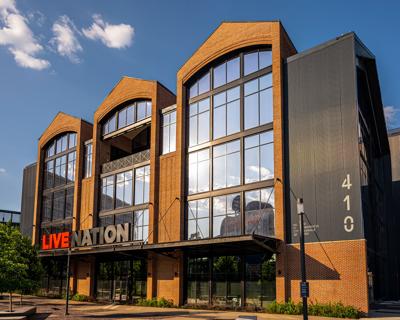According to local lore, Nashville became Music City with a fated performance by the Fisk Jubilee Singers in front of Queen Victoria in 1873. Sometime in the 1920s and 1930s, the gravity moved downtown to the Grand Ole Opry — the Jubilee Singers kept singing, of course, but the industry has a penchant for what’s new, popular and, most of all, what’s making money.
Another few decades and the city’s country stars, labels, studios and executives built 16th and 17th avenues into Music Row. The blocks that once dominated Nashville’s music industry have in the past decade been tagged with historical markers. In 2014, artists, music-biz figures and a philanthropic real estate mogul came together to save RCA Studio A, where artists like The Highwomen, Jason Isbell, Chris Stapleton and others have breathed new life into one of country’s most hallowed spaces. But a lurking sense of novelty on Music Row is also a sign that it has lost its industry pole position, no longer making markets or controlling the business of music. Instead, labels and publishers have to look across town to make sure there’s money coming back to Midtown.
Platforms rose to power over the 2010s as people stopped buying CDs and started streaming, making online markets the city’s new hitmakers. Over the past five years, streaming giants have established strong corporate presences in Nashville. Spotify, Apple Music, YouTube and Amazon all set up local shops here in recent years, favoring downtown and Wedgewood-Houston over Music Row. In May, Napster announced it would move its global headquarters to Nashville. The company that broke ground on music streaming in the early 2000s — before going bankrupt from the copyright backlash — plans to modernize its music services under new CEO Jon Vlassopulos.
Live Nation’s 2021 expansion at the corner of Chestnut Street and Fourth Avenue South is a physical reminder of the other way artists make money in the post-CD era: selling lots of tickets to lots of shows. The Nashville Sounds’ retired guitar-shaped scoreboard, now a decorative lawn ornament in Live Nation’s rear courtyard, is a campy statement piece for the billion-dollar company desperate to justify its new-money throne. Live Nation’s massive glass silos are a reminder that, in today’s music business, a few companies control who eats.
“They’re charting the future of music over there,” says Chris Farren, president of Combustion Music, an independent music publishing company on 18th Avenue South. “They are big-money companies with deep pockets that can have a huge impact — good or bad — on how things go from here. Live Nation, Spotify and Apple alone are billion-dollar companies that dwarf us over here.”
During the glory days of physical media, one hit song could sell an album. When a unit sold for $10 or $16, the money was spread around. Farren refers to the 1980s and 1990s as a “Golden Age” for Nashville labels and industry execs, when hit records could net tens of millions of dollars. A typical record deal gave 85 percent of revenue to the label and 15 percent to the artist.
Today, Spotify kicks back $3,180 in royalties for a song that gets a million streams. Apple pays $7,830 and YouTube pays $2,000 for the same number of listens. Based on artists’ and songwriters’ contracts with labels and publishers, that money gets split even further, with more going to whoever has the music rights (“masters”) and less for songwriters. For Combustion, surviving the 2010s meant adapting with the industry.
“You could get 10 times as much for owning a master than you could for just owning the song, so we leaned into the shift,” Farren tells the Scene. “We started doing more recording and trying to cut better deals with an artist than labels could. We never had leverage with big labels before. Now we do.”
Streaming cut out high-margin CDs, but it also democratized distribution. Printing thousands or millions of CDs used to be pricey bets by labels like Sony and Warner Music Group that could afford to spend a lot of money up front. Now anyone can put music on a platform. The challenge has become how to drive listens — a combination of radio play, media exposure (specifically social media) and getting featured on platforms. Curated playlists like Spotify’s Hot Country and RapCaviar connect huge followings to new songs and artists. They’re also gatekeepers, deciding who gets listens and who gets paid. They make money either way.
“Streaming has just decimated the industry,” says Tristen Gaspadarek, a local artist who worked as a full-time musician from 2008 to 2018. Her songs have millions of listens on Spotify, but that alone doesn’t support a modest living in Nashville. “I wouldn’t even call it an industry anymore when middle-class musicians are on food stamps. After a while, I started to look around and see other people with health care, other people buying houses, things that were impossible for me as a musician. I don’t think anybody besides the really popular musicians are making a living.”
As streaming gained ground, Tristen started diversifying her skills as an artist: recording, marketing, publicity, videography — anything that would cut into her already paltry revenue happened in-house. It’s an age of mass creation, she says, all subject to a vast power imbalance. She points to the Union of Musicians and Allied Workers as a path forward for artists and a glimmer of hope that creative output might be economically viable at some point in the future. She also mentions public funding for musicians, a model being rolled out by the European Union.
“On other platforms, I pay for content,” says Tristen. “I pay for an audiobook. But Spotify opened the floodgates. Live fees have been the same for 30 years. We have to purchase records wholesale from our label, and most people aren’t buying them anymore. We need to organize, and we need to be going on strike.”





